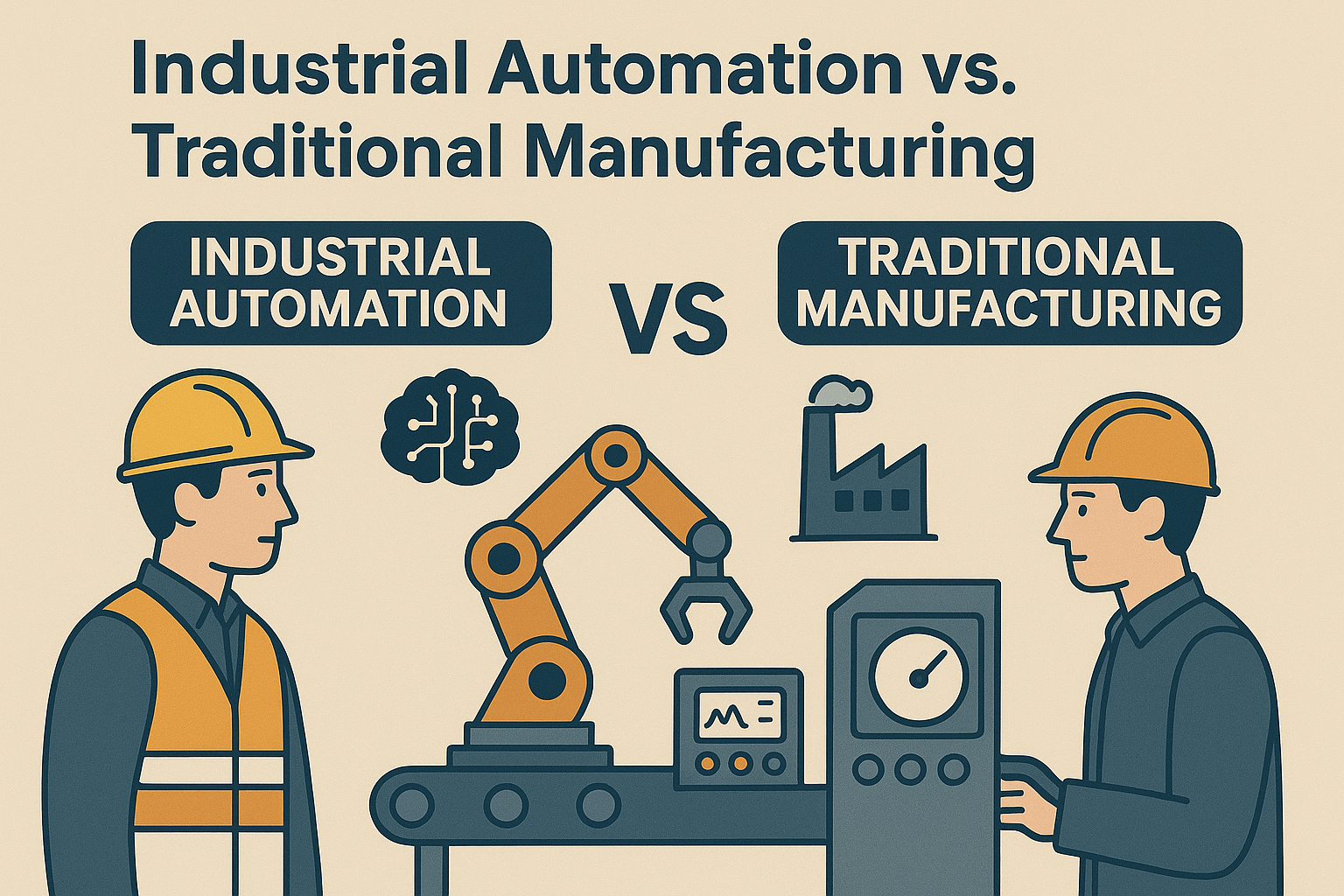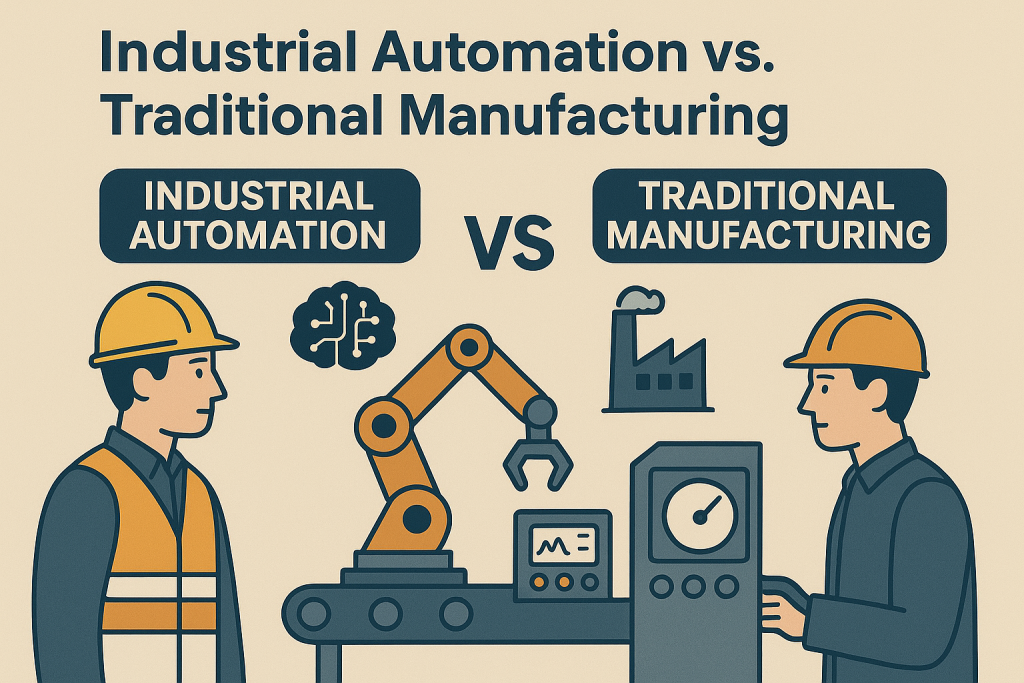
Industrial Automation vs. Traditional Manufacturing: What’s the Difference?
- sofconblogadmin
- Posted on

The manufacturing world is undergoing a dramatic transformation. As industrial automation takes center stage, traditional manufacturing methods are being re-examined for their relevance and efficiency. But what truly sets these two approaches apart? Let’s dive into the key differences, benefits, and what the future holds for each.
What is Traditional Manufacturing?
Traditional manufacturing refers to manual or semi-automated production processes that rely heavily on human labor and stand-alone machines. These methods have powered industries for decades, focusing on mass production, cost efficiency, and established workflows.
Key Features:
- Manual operation of machinery
- Linear, inflexible production lines
- Periodic quality checks (often after production)
- Data collected manually, mostly for historical analysis
- High dependence on workforce for both operation and decision-making.
What is Industrial Automation?
Industrial automation involves using control systems, computers, and robotics to operate machinery and processes with minimal human intervention. It’s the backbone of modern “smart manufacturing,” integrating technologies like IoT, AI, and advanced analytics to optimize every aspect of production.
Key Features:
- Automated machinery and robotics
- Real-time data collection and analysis
- Flexible, easily reconfigurable production lines
- Predictive maintenance and quality control
- Workforce focused on oversight, data analysis, and system management.
Head-to-Head Comparison
| Aspect | Traditional Manufacturing | Industrial Automation |
| Labor Involvement | High; manual tasks dominate | Low for repetitive tasks; focus shifts to technical roles |
| Flexibility | Low; hard to adapt quickly | High; rapid reconfiguration possible |
| Data Usage | Limited, often historical | Extensive, real-time, predictive |
| Quality Control | Periodic inspections | Continuous, real-time monitoring |
| Efficiency | Prone to downtime and errors | Maximized via automation and analytics |
| Resource Use | Often imprecise, can be wasteful | Optimized through data-driven insights |
| Scalability | Best for static, high-volume runs | Excels in dynamic, changing environments |
| Cost Over Time | Moderate; labor and waste add up | Lower; savings from efficiency and reduced downtime |
Key Differences Explained
- Automation and Flexibility
- Traditional: Production lines are rigid; changes require significant downtime and effort.
- Automation: Advanced robotics and IoT enable quick adaptation to market demands, minimizing disruptions.
- Data Utilization
- Traditional: Data is collected manually, limiting real-time insights.
- Automation: IoT sensors and analytics provide actionable, real-time data for proactive decision-making.
- Production Efficiency
- Traditional: Manual workflows are susceptible to errors and unplanned downtime.
- Automation: Automated systems run continuously, identify bottlenecks, and optimize output.
- Resource Optimization
- Traditional: Resource management is less precise, leading to waste.
- Automation: Sensors monitor usage, enabling precise allocation and sustainability1.
- Workforce Roles
- Traditional: Workers operate machines and inspect quality.
- Automation: Workers oversee systems, analyze data, and manage exceptions—requiring upskilling and technical expertise.
- Quality Control
- Traditional: Inspections are periodic; defects often caught after production.
- Automation: Real-time monitoring detects and corrects defects instantly, reducing waste and improving quality.
Why Make the Shift to Automation?
Industrial automation offers a range of advantages over traditional methods:
- Higher productivity through 24/7 operations and reduced manual intervention
- Better product quality via continuous monitoring and AI-driven controls
- Lower operational costs by minimizing waste, downtime, and labor for repetitive tasks
- Faster, data-driven decision-making that keeps pace with market changes
- Greater sustainability through optimized resource use and reduced emissions
The Future of Manufacturing
As customer expectations evolve—demanding more customization, faster delivery, and higher quality—industrial automation is becoming essential for manufacturers who want to stay competitive. While traditional manufacturing laid the foundation, automation is driving the next era of efficiency, flexibility, and innovation.
In Summary
Industrial automation and traditional manufacturing differ fundamentally in their approach to labor, efficiency, data, and adaptability. Automation is not just about replacing workers with machines—it’s about creating smarter, more responsive, and sustainable factories for the future. The choice between the two will shape the success of manufacturers in a rapidly changing world.